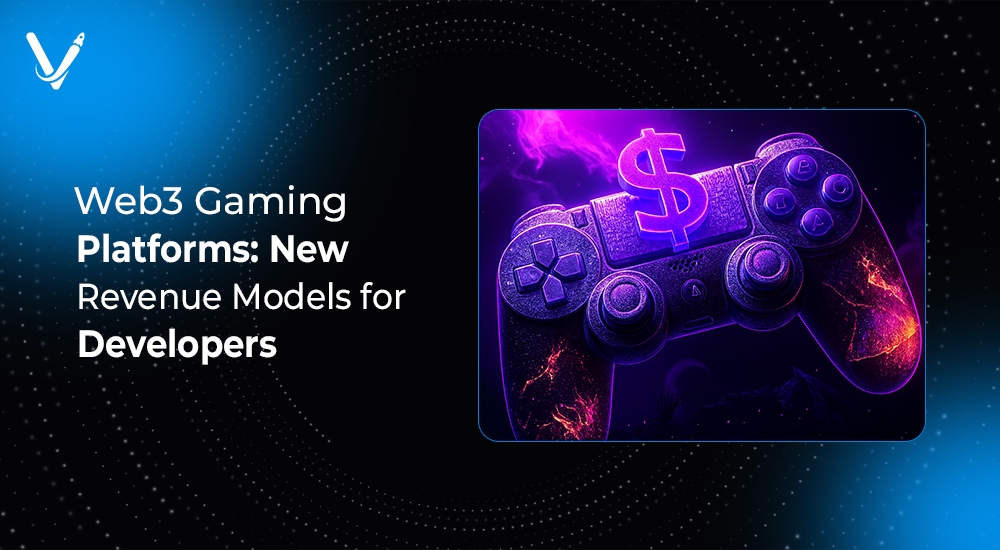Web3 Gaming Platforms: New Revenue Models for Developers


- Aug 6, 2025



The gaming industry has always been a fertile ground for innovation—graphical evolution, mobile gaming, cloud gaming, and now, the rise of Web3. Unlike traditional platforms, Web3 gaming platforms give players true ownership of assets and enable developers to explore entirely new revenue models beyond the confines of centralized app stores.
Web3 transforms games into open economies where value is shared, player participation is rewarded, and in-game items are no longer locked behind walled gardens. For game developers, this new paradigm introduces tokenized economies, dynamic royalties, community governance, and monetization models that were previously unthinkable.
This blog takes a deep dive into how Web3 gaming is reshaping developer monetization. We’ll explore real-world platforms, technologies, and opportunities, alongside the challenges and future outlook. Whether you're building an indie title or a metaverse experience, understanding these shifts is crucial to staying relevant and profitable in the gaming world of 2025 and beyond.
Web3 gaming refers to decentralized games built using blockchain technologies that enable players to own, trade, and earn through in-game assets. Unlike traditional games where assets are locked in a closed ecosystem, Web3 games use NFTs and crypto tokens to empower players with real, transferable ownership.
These concepts form the foundation of the new revenue landscape developers are tapping into.
In the Web2 era, game developers primarily relied on:
While effective, these models often placed the platform or publisher in control, limiting developers’ revenue share and their creative or commercial freedom.
Web3 flips the script. By leveraging decentralization, developers unlock:
These mechanisms offer long-tail revenue streams, increased community involvement, and reduced reliance on middlemen.
NFTs serve as game items, skins, characters, land, or weapons. Developers can sell these assets during launch or through seasonal drops.
The twist? NFTs on blockchains like Ethereum or Polygon support on-chain royalties. Every time a player resells a skin or character, a cut (e.g., 5–10%) automatically goes back to the developer.
Example: Axie Infinity generated over $1 billion in NFT sales, with developers receiving royalties every time a creature was traded between players.
Developers can create and issue native tokens that power game economies. These tokens are used for:
When these tokens are listed on exchanges, they can gain real-world value—adding a financial dimension for both developers and players.
Example: Gala Games uses its native $GALA token for game utility and ecosystem rewards.
Web3 gaming platforms support decentralized or integrated marketplaces where players trade assets peer-to-peer. Developers can earn by:
Example: Immutable X enables fee sharing between marketplace builders and creators, providing scalable monetization at low gas cost.
Virtual land is a cornerstone of metaverse-style Web3 games. Developers can sell land parcels and enable players to:
Developers benefit by selling initial land plots and taking a cut from secondary market trades or in-game tax systems.
Example: The Sandbox sold virtual land NFTs for millions and enabled users to create monetized mini-games.
Web3 games often launch DAOs, giving token holders a say in roadmap decisions, content launches, and funding.
Developers benefit from:
Example: Illuvium leverages a DAO for treasury management, reward distribution, and expansion votes.
Unlike traditional games, NFTs and tokens in Web3 games can sometimes be used across titles or platforms.
Developers creating compatible or extended experiences can monetize through:
This creates multiple revenue layers for devs building within a shared universe.
Used by games like Gods Unchained and Guild of Guardians.
Despite setbacks due to speculative bubbles, Axie laid the foundation for tokenized economies.
Poorly designed token economies can lead to inflation, dump cycles, and player exit. Developers must:
Tokens may be treated as securities in some jurisdictions. Developers must monitor:
Partnering with legal advisors or compliance platforms is crucial.
Web3 games often suffer from:
To succeed, developers should focus on seamless onboarding, custodial wallet options, and fiat integration.
High-value NFTs or tokens can scare off casual players. Developers should:
Begin with cosmetic NFTs or a loyalty token. Avoid fully tokenized economies until your user base grows.
Use platforms like:
These reduce development time and lower barrier to entry.
Platforms like Avalanche, Polygon, and Immutable X often offer developer incentives, marketing support, and community bootstrapping.
Game guilds help with early traction, liquidity provision, and playtesting. Engage with communities like:
These act as investor-players who support quality Web3 projects.
Tools like Scenario and Inworld AI allow devs to create stories and assets with AI. Pairing this with Web3 opens doors for:
Modders can now sell their creations as NFTs. Web3 supports:
With Web3, revenue can be auto-split between artists, devs, writers, marketers, and voice actors based on smart contract logic—eliminating intermediaries.
Dev kits like the Sandbox GameMaker or OnCyber SDKs may evolve to include:
Web3 gaming platforms are unlocking a golden era of innovation, collaboration, and monetization for developers. The shift is not only technical—it’s philosophical. Control is moving away from corporations and toward creators and communities.
For developers willing to navigate the early challenges, Web3 offers unmatched flexibility, new income streams, and deeper player engagement. This is not just a trend—it’s a transformation.
If you're a developer looking to integrate Web3 into your game or build a full-fledged decentralized experience, Vasundhara Infotech is your strategic partner. Our team understands blockchain, gaming, and user-centric design to help you unlock the true potential of Web3.
Copyright © 2025 Vasundhara Infotech. All Rights Reserved.